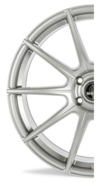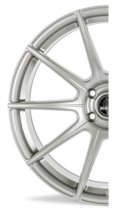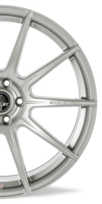Spatio-temporal relationships 1
Creating an experience of being surrounded by sound was central to my involvement in the "Wheels within wheels" project. If the sounding events were sufficiently rich, one could give up the idea of chasing them, and rather wait for them to pass by. During an orchestral workshop in Stavanger (2001-2002) it was noted that what I wrote "was like a ghost passing through the orchestra".
Stockhausen's "Gruppen" for three orchestral groups is often performed twice, and the audience is encouraged to change seats. Variable perspectives of distance and proximity are intended parts of this experience. "Gruppen" has density and rapidly changing events where it would not make sense to walk around and chase the sounds, it requires attentive listening over time.
The electro acoustic tracks for Iannis Xenakis's "Polytope de Persepolis" (1971), on the other hand, is a very loud and continous composition, where his mobile concert situation made sense. There is no way moving around will be louder than the music. He was not using a concert hall, but the landscape of the iranian desert, with a crowd of children running over the hills with torches, and a performance area with as many loudspeakers as the Shiraz festival could afford to offer Xenakis. All the polytopes had visual elements, like lazers, light shows, goats with lights and bells, or army searchlights. They were spectacles with a large audience. 2
Iannis Xenakis has described 7 types of spatio-temporal relationships. 3
- "The sources are placed in front of the audience". 4 This is the conventional concert stage.
- "The sources are placed in the center". 5 This is the ancient greek theatre.
- "The sources surround the audience". 6 This would include antiphonal repertoire from venetian renaissance and baroque to Stockhausens "Gruppen".
- "The sources and audience are freely mixed." 7 The boundaries between audiences and musicians are gone, like in Xenakis's orcestral works "Nomos gamma" and "Terretektorh". x
- The linear relationship, "military parades, religious processions, bike races, official receptions". 8
- Any mix of the five above. 9 The polytopes had examples of mixed situations.
We could add the use of mass media, 10 streaming and social media. 11 Performance can take part between different cities and different parts of the world. A lot of performance situations have been explored, and most of them are today not at all new. Sounds are fragile. An opera production can be a feast for ears and eyes, while it may be easy to distract attention from detailed, rich and microscopic nuances of timbre, morphological qualities of sound and spatial movement. The tragedy is when we are not listening.
During the development of his work "Prometeo, the tragedy of listening", Luigi Nono decided to take visual elements out of it. It would be about spatial relationships happening at different levels and positions in the performance space especially built by Renzo Piano, with the live electronic treatment and spatialization of the performance.
"Die Resultate waren bemerkenswert, aber von einem gewissen Moment an begann ich, in mir eine Art antivisuelles Syndrom zu spüren, das mich nicht nur von jedem visuellen Projekt Abstand nehmen sondern in mir auch all die Erfahrungen, die ich im Freiburger Studio gemacht hatte, zur Explosion kommen lies. Plötzlich stand ich ganz im Bann der Notwendigkeit des hörens an sich, der Problematik und der großen Spannungen, die es auslösen konnte." 12
For Nono, it was not just about surface concepts and situations, but a concentrated listening into fragile and complex sound phenomena. He described his home town Venice as "an acoustic multiverse".
"Venedig ist ein komplexes System, das genau jenes mehrdimensionale Hören bietet (...). Die Klänge der Glocken breiten sich in mehreren Richtungen aus: einige addieren sich, werden von Wasser getragen, von Kanälen übertragen... andere verschwinden fast völlig, andere beziehen sich auf verschiedene Art auf andere Signale aus der Lagune und der Stadt selbst. Venedig ist ein akustisches Multiversum, das dem vorherrschenden System, den Klang zu übertragen und zu hören, absolut entgegengesetzt ist, an das wir seit Jahrhunderten gewöhnt sind." 13
The focus for the "Mouvance III: Distortion" concert should not be the newness of the performance situation, rather finding a situation where the musical expressions and spatial perspectives can come through in a satisfying way. We used both the 1 hour concert format within a tight festival schedule, and the infinite sound installation, both initiating situations of concentrated listening. The medieval instruments are not loud compared to their modern counterparts. If the same piece is performed twice in the program, with the musicians performing from two different parts of the room, each person in the audience will be able to hear the piece close up and distant without moving.
Ambisonics decodings should create a sweet spot in the middle of the hall, where you will have the most optimal spatial perspective, and sound installation elements of our concert were operating within this paradigm. It would not enhance your experience of spatial perspective to move to the sides. Trond Lossius developed his Distance Based Amplitude Panning (DBAP) for art galleries and locations where you don't have the sweet spot thinking, you are supposed to move around. I used DBAP for a few live processings of the musicians.
The "Wheels within wheels" sound installation was playing for several days. The visitors could come and go, while the sounds could invite people to stay for a longer time. There was no loop to wait for, as sounds were continously appearing in new combinations. For a written composition as well, it cannot be a question of exhausting all possibilities, rather finding a satisfying ending.
The day after our concert, the musicans performed within the sound installation at Østre. Textures like the granular attacks had already found their way into their improvisation vocabulary.



